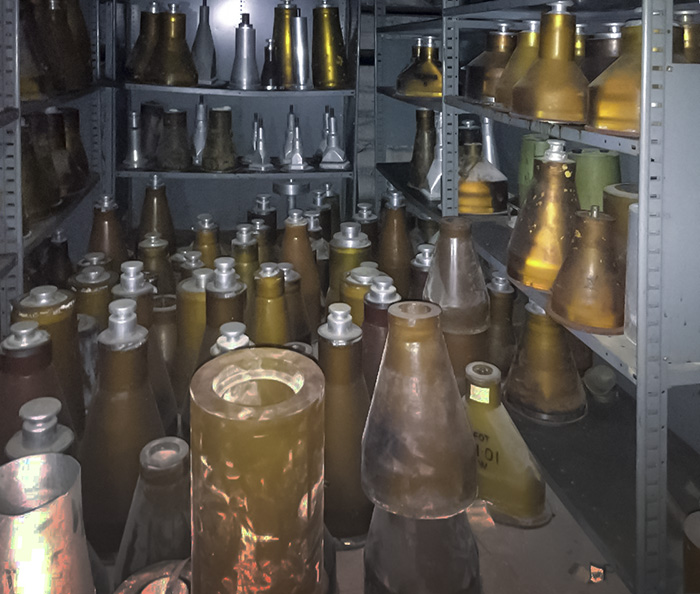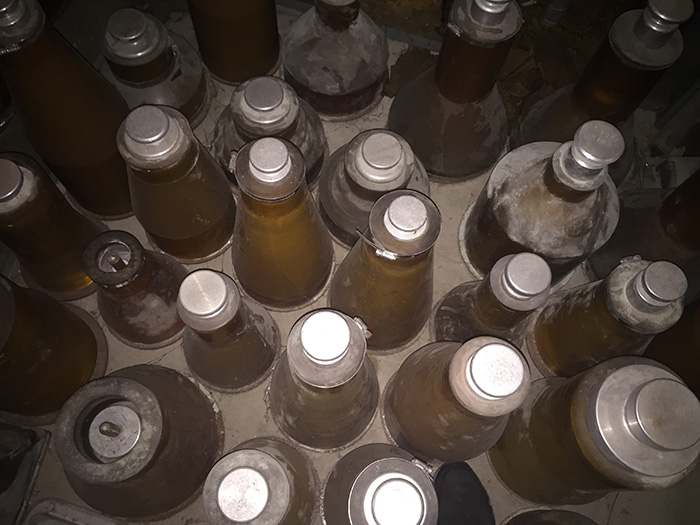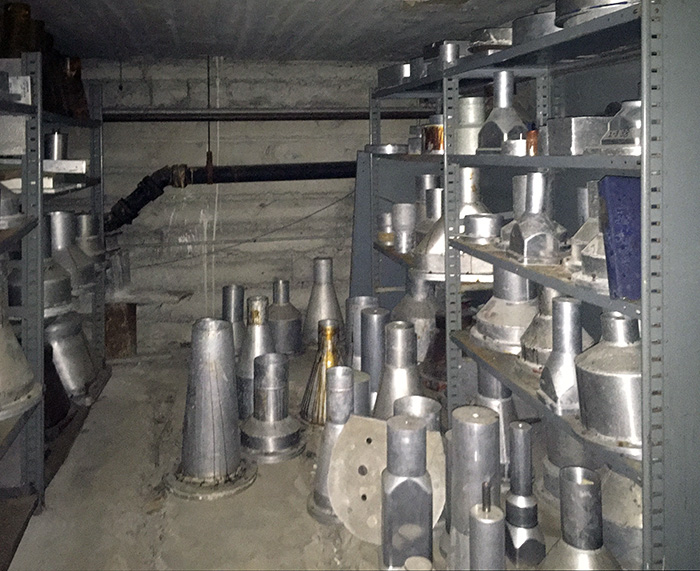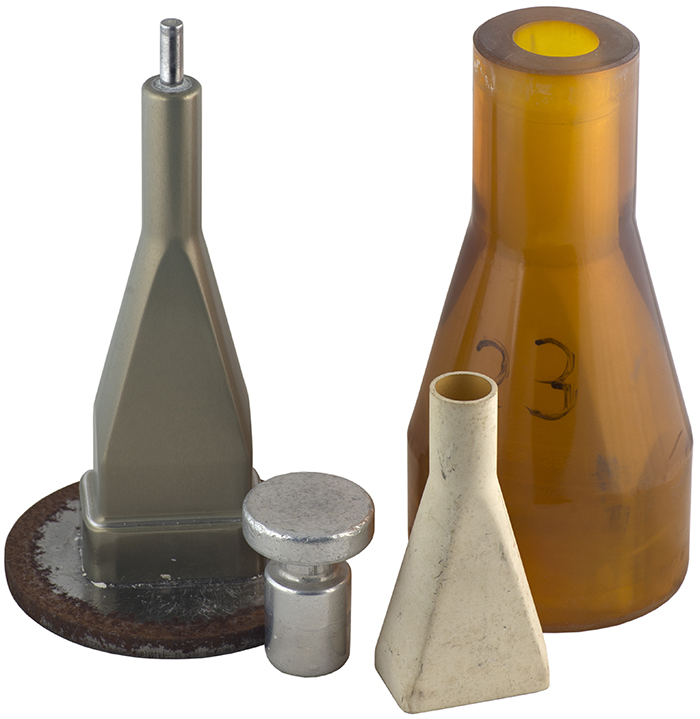Tektronix personnel were recently in the crawl space below building 13, the home of the museum and the former home of the Ceramics Operation, for some routine maintenance. They discovered a storage area filled with CRT funnel molds. This must have been used as storage for Ceramics and then long forgotten.

We now have several of these molds on display at the museum. The 1967 Building A Ceramic CRT film in our Video Gallery shows these molds in operation.
Former employee Bill Gellatly wrote this story about the history of the use of ceramics in CRTs. Material for this was originally written by Bill as a presentation at the NW Chapter of Society for Information Display in January 2012.
CERAMIC CRT TOOLING FOUND by Bill Gellatly
A cache of tooling for ceramic CRT funnels was recently found in a basement storage area of the Ceramics Plant that now houses the vintageTek museum. Here is a bit of history describing Tek’s use of ceramic components to produce CRT’s.
Much has been written about the role of the CRT in Tektronix’ success, the technical and business challenges of buying commercial CRTs. An early decision to produce our own glass CRT’s was quickly handsomely rewarded in superior performance and reliability. The booming TV industry had already produced a B&W set for every home in America, and was poised to do the same with color, placing high demands on suppliers of the glass components for CRTs..
In just a few years, our requests for small numbers of increasingly complex glass shapes were met with long tooling and development cycles. Implosion-safe designs were still empirical, and the validation cycles slow. CRT’s for oscilloscopes were now on their own market trajectory.
The economical solution was Tek's development of ceramic funnels. It was going to be a leap of faith and a test of the skills of everyone in the then-small ceramics department. Isostatic pressing (equal pressures in all axes) was being used for large high voltage insulators, but not in high volumes and not for vacuum-grade applications. If successful, it would reduce cost and reduce time-to-market.
Why Tek would look for producers Navy Ship Guns?
In order to get a consistent glassy-phase, vacuum-grade ceramic, the pressure during compaction must be uniform in all axes. The isostatic process uses high-pressure hydraulic oil, running at 8,000 to 10,000 psi, that charged a transfer reservoir and flexible fluid barrier transmitting that pressure to water that flows into pressure vessels made from surplus gun-barrels with breech locks. Tek’s first presses were limited to about 9-inch inside diameter, but with the decision to make a storage tube with a display of 8 x 10 inches, the tapered funnel between the faceplate and the electron gun called for a much larger pressure vessel, and the story I heard was that it was bought from the manufacturer of large navy guns, but not from Navy surplus (which would have had an unknown stress cycle history).
The tooling consists of an inner mold machined from 7075-T6 aluminum, and a flexible outer mold made from cast polyurethane. The mold is filled with ceramic powder prepared with adequate moisture to hold its form after the high-pressure cycle. The volumetric compaction ratio between powder and pressed shapes is about 2.2:1, so the urethane boot must be very tough to produce a reasonable volume of parts without failure, or loss of the water-tight seal for the pressure cycle. The green ceramic shrinks another few percent when fired, and can still slump if horizontal surfaces are not supported.
564 – Tek’s First Tektronix Storage Tube, and the first ceramic funnel
The storage tube employed bi-stable storage invented by Bob Anderson. It utilized flood guns to supply low-energy electrons in addition to the high-energy electrons from the writing gun. The effect is that the “flood” electrons keep providing illumination for any spot written once by the writing gun.
The 564 was a good seller but not sufficient to provide the return on investment for the ceramics infrastructure and manufacturing equipment, so it was very beneficial to have the other CRT designs added to the mix. This was a case where our innovation and internal manufacturing had good leverage. As a benchtop scope, weight was not paramount.
453A Conversion to Ceramic
In absence of finite-element analysis, Tek designs carried piecemeal surface stiffness analysis into geometry. The design for the portable instrument made strength and weight important. Tooling for the complex geometry was made before Tek had adopted CNC- machining processes, so it was a tedious task with many precise setups. The interior mold is machined from abrasion-resistant aluminum, and the outer shape is made with a urethane “boot” that requires its own molding operation. The urethane flows the gravity-fed powder to be compressed uniformly.
For Information Display needs – A CRT with and 8 x 10 image!
Designing a ceramic envelope geometry of this size was quite a challenge. Early versions of Finite Element Modeling were becoming a reality, so Dale Rath took an early run at producing a model that could raise our confidence in pressing a funnel that would withstand the firing cycle without collapsing. The design of the flood guns was done with a ring-shaped stamping with several guns, each running at just a few hundred volts (relative to the faceplate). That forced the funnel into something like an inverted red-clay flower pot, but beginning as a rectangle at the faceplate and moving to a cylindrical form toward the rear. The faceplate was a half an inch thick! The bending forces on the glass had to be resisted by the wide flanges of the funnel, and not exceed the tensile strength of the low-temperature glass seal called “frit.” That same frit material was used for the feedthroughs that connected the gold-resin electrodes called “wall bands” and the flood gun connections. To withstand mechanical shock and implosion forces, the faceplate was surrounded by a rubber molding which was, in turn, retained by the chassis.
Key players players
Bob DuFresne - Plant Manager, Dee Sherwood – Engineering Manager, Dale Thornberg - Quality Manager, Mike Pessl - Technician in metrology and quality, Bob Skidmore - Quality statistician, Mike Bostwick - Manufacturing Engineering Manager, Larry Tucker - Lead Tooling designer, Bud Maguire - Tooling machinist, John Kazmir - Machine shop manager, Bill Gellatly - Process equipment design, some tooling design, John McAnulty - Mfg Engineer with Ceramics background and Navy experience with ship artillery, John Stoops – Urethane molding specialist.


We have on display the mold for the 200 series CRT ceramic funnel.

